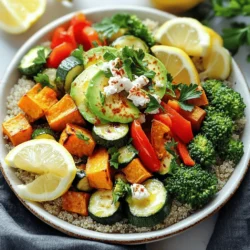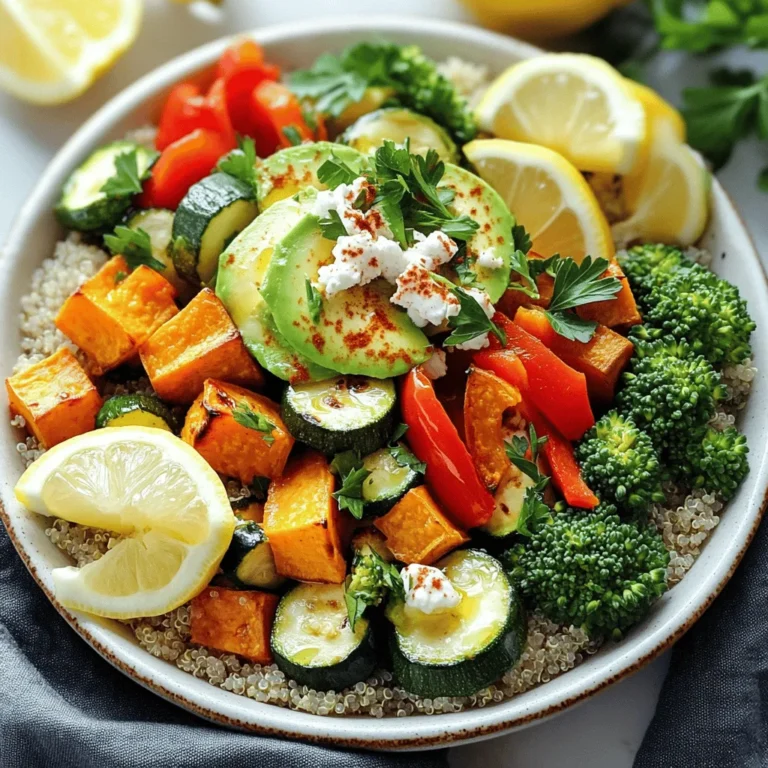Are you ready to elevate your meals with a bowl full of colorful goodness? This Roasted Veggie Power Bowl is not just tasty; it’s packed with fresh flavors and nutrients. With vibrant veggies, fluffy quinoa, and your choice of toppings, you can make it uniquely yours. Whether you’re a meal prep pro or just looking for a healthy option, this guide will help you create a delightful dish that satisfies your cravings and nourishes your body. Let’s dive in!
Ingredients
For a Roasted Veggie Power Bowl, you need some tasty and healthy ingredients. Here’s what you will use:
– 1 cup quinoa, rinsed
– 2 cups vegetable broth or water
– 2 medium sweet potatoes, peeled and cubed
– 1 red bell pepper, sliced
– 1 zucchini, sliced
– 1 cup broccoli florets
– 2 tablespoons olive oil
– 1 teaspoon smoked paprika
– 1 teaspoon garlic powder
– Salt and pepper to taste
– 1 avocado, sliced
– 1/4 cup feta cheese, crumbled (optional)
– Fresh parsley or cilantro, for garnish
– Lemon wedges, for serving
Each ingredient plays a role in making this bowl delicious. Quinoa is a great base. It is high in protein and very filling. Sweet potatoes add a sweet touch and a lot of nutrients. The bell pepper, zucchini, and broccoli bring color and crunch to your meal.
Olive oil helps the veggies roast up nicely. The spices like smoked paprika and garlic powder give a warm flavor. Adding avocado makes the bowl creamy and rich. Feta cheese, if you choose to use it, adds a nice salty flavor. Fresh herbs and lemon wedges finish the dish perfectly.
This recipe is all about balance. You have hearty grains, colorful veggies, and fresh toppings. This gives you a power bowl packed with flavor and goodness.
Step-by-Step Instructions
Preparing the Quinoa
To start, bring 2 cups of vegetable broth or water to a boil in a medium saucepan. This will add flavor to your quinoa. Next, add 1 cup of rinsed quinoa to the boiling liquid. Lower the heat and cover the pot. Let it simmer for about 15 minutes. You will know it’s ready when all the liquid is absorbed. Once it’s done, remove it from heat and fluff the quinoa with a fork. This step makes it light and airy.
Preparing Roasted Vegetables
Now, let’s focus on the roasted vegetables. In a large bowl, combine 2 cubed sweet potatoes, 1 sliced red bell pepper, 1 sliced zucchini, and 1 cup of broccoli florets. Drizzle 2 tablespoons of olive oil over the veggies. Sprinkle 1 teaspoon of smoked paprika, 1 teaspoon of garlic powder, salt, and pepper to taste. Toss everything together so the veggies are evenly coated.
Next, spread the seasoned vegetables in a single layer on a baking sheet lined with parchment paper. Roast them in the preheated oven at 425°F (220°C) for 20 to 25 minutes. Stir halfway through to ensure even cooking. The veggies should be tender and slightly caramelized when they’re done.
Assembling the Power Bowl
Once your quinoa and roasted veggies are ready, it’s time to assemble your power bowl. Start with a generous layer of fluffy quinoa as your base. Next, add a big scoop of the roasted vegetables on top. For an extra touch, add sliced avocado and crumbled feta cheese, if you like. Finally, garnish your bowl with fresh parsley or cilantro. Serve with lemon wedges on the side to add some zesty goodness.
Tips & Tricks
Cooking Tips
For the best flavor, roast your veggies at 425°F (220°C). This high heat gives them a nice caramelized finish. Roast for 20-25 minutes. Stir them halfway to ensure even cooking.
To make fluffy quinoa, rinse it well before cooking. This removes the bitter coating. Use two cups of broth or water for each cup of quinoa. After cooking, let it sit for five minutes. Fluff it with a fork to keep it light and airy.
Ingredient Substitutions
If you don’t have quinoa, try brown rice or farro. Both add a hearty base. You can also swap vegetables based on what you like or have. Carrots, asparagus, or cauliflower work well.
For a dairy-free option, skip the feta cheese or use a plant-based alternative. Nutritional yeast can add a cheesy flavor without the dairy.
Meal Prep Tips
Prep your veggies ahead of time. Chop them and store in the fridge for up to three days. This saves time on busy nights.
To store leftovers, use airtight containers. Keep the quinoa and veggies separate to maintain texture. They will last in the fridge for about three days. Reheat gently to avoid sogginess.

Variations
Customizing the Bowl
You can easily change your roasted veggie power bowl to fit your taste. Adding proteins boosts flavor and nutrients. Try chickpeas for a vegan option. They are rich in protein and fiber. If you prefer meat, grilled chicken adds a savory touch.
You can also mix in different grains. Brown rice provides a hearty base. Farro adds a nice chewiness. Both grains offer more texture. They make your bowl even more filling.
Seasonal Variations
Using seasonal vegetables can really brighten your bowl. Fresh veggies taste better and add color. In spring, try asparagus and peas. In fall, use butternut squash or Brussels sprouts.
Spices and dressings can also change your bowl’s flavor. A sprinkle of cumin adds warmth. A drizzle of tahini gives a nutty taste. Experiment with your favorite flavors to keep things interesting.
Dietary Preferences
This recipe is flexible for many diets. For vegan eaters, skip the feta cheese. You can also use dairy-free cheese options. Gluten-free? Simply choose grains like quinoa or rice.
Kids may enjoy this bowl too. Serve the veggies with a fun dip, like ranch. You can also use smaller pieces of veggies for easier eating. Make it colorful and fun to appeal to young diners.
Storage Info
Storing Leftovers
To keep your Roasted Veggie Power Bowl fresh, place it in an airtight container. Store it in the fridge. The flavors meld nicely, making it even better the next day. You can eat leftovers for up to four days. If you want to keep the veggies crisp, store them separately from the quinoa and other toppings.
Reheating Instructions
To reheat, use the microwave or oven. If using a microwave, heat the quinoa and veggies in short bursts. Stir every minute to avoid hot spots. In the oven, preheat to 350°F. Spread the veggies on a baking sheet and reheat for about 10 minutes. To avoid sogginess, cover the dish loosely with foil. This way, you keep the steam in without making everything mushy.
Freezing Options
Yes, you can freeze the power bowl! It’s best to freeze individual components. Cooked quinoa and roasted veggies freeze well. Place them in freezer-safe bags. Squeeze out the air and seal tightly. For best quality, use them within three months. When ready to eat, thaw in the fridge overnight. Reheat as mentioned above for the best taste.Enjoy your flavorful bowl!
FAQs
How do I make a roasted veggie power bowl?
To make a roasted veggie power bowl, follow these steps:
1. Preheat your oven to 425°F (220°C).
2. Cook the quinoa by boiling 2 cups of vegetable broth or water. Add 1 cup of rinsed quinoa, cover, and simmer for about 15 minutes. Fluff it with a fork after cooking.
3. Prepare the veggies by cubing 2 medium sweet potatoes, slicing 1 red bell pepper, 1 zucchini, and measuring 1 cup of broccoli florets.
4. Season the vegetables in a large bowl with 2 tablespoons of olive oil, 1 teaspoon of smoked paprika, 1 teaspoon of garlic powder, salt, and pepper. Toss until coated.
5. Roast the veggies on a baking sheet lined with parchment paper for 20-25 minutes, stirring halfway through.
6. Assemble your bowl with a base of quinoa, topped with the roasted veggies, sliced avocado, and optional feta cheese.
7. Garnish with fresh herbs and serve with lemon wedges for a zesty touch.
Can I use frozen vegetables for this recipe?
You can use frozen vegetables, but there are pros and cons:
– Pros:
– Frozen veggies are quick and easy to use.
– They often retain nutrients well since they are frozen soon after harvest.
– Cons:
– Frozen veggies may release more water when roasted, leading to a softer texture.
– They may lack the fresh taste of seasonal vegetables.
If you choose frozen, try roasting them for a bit longer to achieve a nice texture.
What are the health benefits of a power bowl?
Power bowls offer many health benefits:
– Nutrient-rich: They combine whole grains, veggies, and healthy fats.
– Balanced meal: You get protein, fiber, and vitamins in one dish.
– Customizable: You can adjust ingredients based on your dietary needs.
Power bowls help you eat a variety of foods, making it easier to meet your nutrition goals.
This blog post outlines how to create a delicious roasted veggie power bowl. We covered the main ingredients like quinoa, sweet potatoes, and fresh herbs. I shared step-by-step instructions for cooking quinoa and roasting vegetables. Don’t forget the tips for meal prep and storing leftovers!
You can customize your bowl with proteins and seasonal veggies, making it fit your needs. This dish is not only tasty but also packs many nutrients. Enjoy mixing flavors while making a healthy meal for you!


